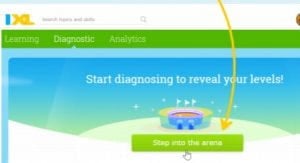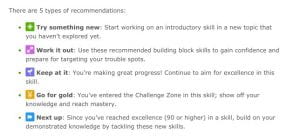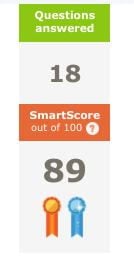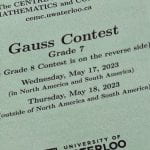
Now, that as students, parents, and teachers, you’ve have had some time navigating the basics of IXL. I wanted to give you a little more insight into what the work you,(as a student) or you as a parent have been doing/seeing as result of the time and practice your son/daughter is putting in. Here are four things in which may be of interest to you: The Real-Time Diagnostic, The Recommendation Wall, Teacher Suggested Skills, and The SMARTScore.
The Real-Time Diagnostic

As in the previous blog post, I pushed out a lot of information, and one area included the Diagnostic portion. To go back and read the entire blog post again, you can so here. But for this post, I just want to highlight a few important key things to remember when using the real-time Diagnostic.
- As independent as possible- if a student doesn’t know- encourage them to click the “I haven’t learned this yet button” on the bottom right
- Students receive personalized recommendations that help them understand what actions to take for growth
- Students play a more active role in their ongoing learning journey, and teachers can also use this truly up-to-date snapshot of their students’ understanding to challenge them at just the right level.
- Diagnostics can be done anytime, and eventually once comfortable; completing at least 5-10 Diagnostic questions once a week to keep recommendations current and up to date
- The more you do, the more narrowed down your level becomes
- Levels with a Star have pinpointed an exact level and have a single number in the corresponding box.
- A diagnostic level of 500 in a math strand represents a readiness to begin working on skills at the grade-five level. If a student’s number is 550, it indicates the student is halfway through the grade-five level. A 750 indicates the student is halfway through the grade-seven level.
The Recommendation Wall
IXL Recomm endations are personalized suggestions for math skills. They update in real time and are based on the individual student’s skill practice and demonstrated knowledge levels in the Real-Time Diagnostic, providing relevant guidance for each student’s next steps.
endations are personalized suggestions for math skills. They update in real time and are based on the individual student’s skill practice and demonstrated knowledge levels in the Real-Time Diagnostic, providing relevant guidance for each student’s next steps.
With recommendations, students receive targeted support specific to their individual needs, while at the same time, they are empowered to explore and take ownership of their personal learning path. They can access this wall at anytime and work through the skills as they wish or as recommended by their teacher.
The Teacher Suggested Skills
Teachers may want to assign specific skills to a class, group of students or even individual students. When a teacher does this, students will see a yellow star next to any skill that you have suggested to them. They also can go to the top of their Recommendations wall to see a list of all the skills you have starred for them! It is important to note that the suggested skills will remain there until the teacher removes it. Your scores automatically save as you go, and your teacher can see them in real-time. You teacher may also give you a goal for that skill (i.e. a SMARTScore of at least 80, or maybe do at least 20 questions etc.)
assign specific skills to a class, group of students or even individual students. When a teacher does this, students will see a yellow star next to any skill that you have suggested to them. They also can go to the top of their Recommendations wall to see a list of all the skills you have starred for them! It is important to note that the suggested skills will remain there until the teacher removes it. Your scores automatically save as you go, and your teacher can see them in real-time. You teacher may also give you a goal for that skill (i.e. a SMARTScore of at least 80, or maybe do at least 20 questions etc.)
The SMARTScore
 The SmartScore is based on IXL’s proprietary algorithm and is the best possible measure of how well a student understands a skill. With the SmartScore, the learning process is rewarded and your son/daughter are constantly reassessed.
The SmartScore is based on IXL’s proprietary algorithm and is the best possible measure of how well a student understands a skill. With the SmartScore, the learning process is rewarded and your son/daughter are constantly reassessed.
When a student starts practising a skill, the SmartScore starts at 0. As the student answers questions correctly, the SmartScore increases. If a question is answered incorrectly, the score decreases. However, the SmartScore is not just based on the percentage of questions correct. It is calculated using many factors, including the number of questions completed, question difficulty and consistency, and offers superior accuracy in assessing student achievement.
A skill is mastered when the SmartScore reaches 100, but the number of questions it takes to master a skill varies with every student. To continuously motivate students, teachers will recommend setting other practice milestones along the way to mastery. A score of 80 is good, and a score of 90 is considered excellent. When a student finally achieves skill mastery, you can be confident that they truly understand the skill.





